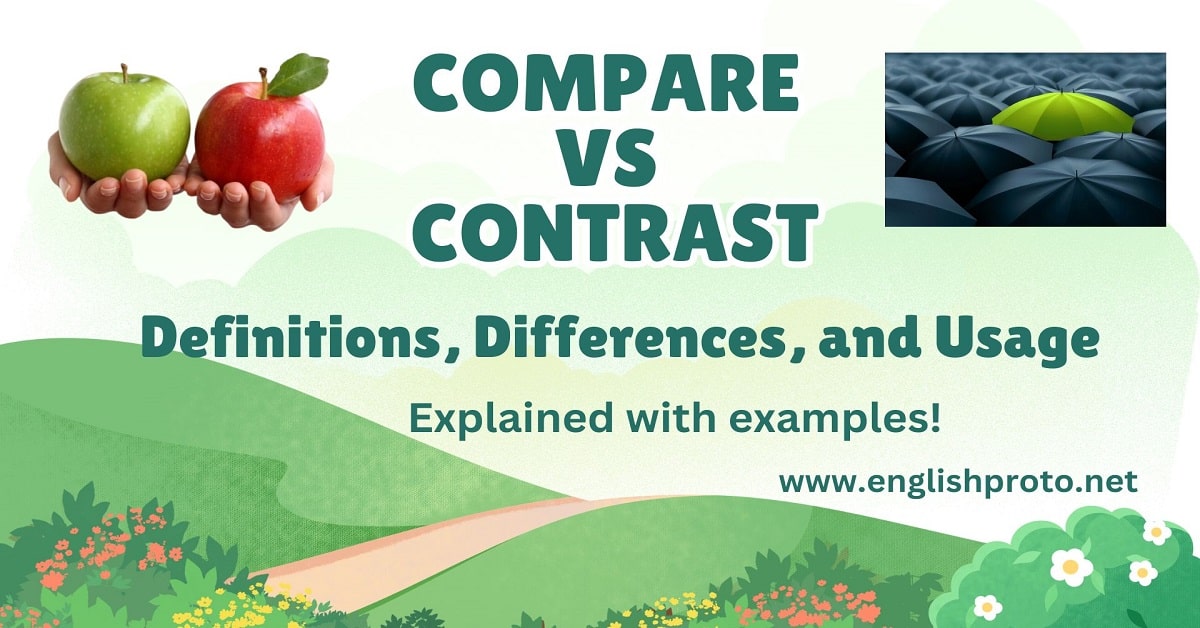Compare vs Contrast: Definitions, Differences, and Usage-it’s a pairing you’ve likely seen a hundred times, but do you know the difference? These terms are more than just academic buzzwords; they’re tools that sharpen your ability to think, write, and communicate clearly.
Whether you’re crafting an essay, analyzing ideas, or making a decision, understanding how to use these concepts can transform the way you express yourself.
If you’ve ever paused and wondered, “Am I comparing or contrasting?” you’re not alone! This article is your ultimate guide to mastering the difference. Let’s dive in and unlock the power of these essential skills together.
The Importance of Understanding Compare and Contrast
Why should you care about the distinction between compare and contrast? These terms are foundational in critical thinking, academic writing, and professional communication.
They help structure arguments, analyze ideas, and clarify relationships between concepts. Misusing them can lead to vague or incorrect statements, especially when you are tasked with examining similarities or differences in essays, reports, or presentations.
For example, a teacher might ask students to “compare and contrast” two historical events. Without understanding the specific focus of compare and contrast, students may struggle to address the assignment properly, leading to a loss of marks or incomplete analysis.
Similarly, in professional scenarios, a report that confuses these terms may fail to communicate its findings effectively.
Quick Summary
Let’s start with a concise overview:
- Compare means identifying similarities between two or more items. It focuses on what is shared or alike.
- Contrast means identifying differences between items. It emphasizes what is distinct or opposing.
- Both terms are often paired together but serve distinct purposes.
Key Takeaways:
- Use compare when looking for commonalities.
- Use contrast when exploring dissimilarities.
- Both terms enrich analysis and help organize information logically.
Reasons for Confusion
Why do people mix up compare and contrast so often? Let’s explore the main culprits:
- Shared Contexts: These terms often appear together, as in the phrase “compare and contrast.” This pairing creates the misconception that they mean the same thing.
- Overlap in Analysis: When comparing two things, differences may naturally arise, and vice versa. For instance, while comparing two novels, you may notice differing narrative styles, leading to inadvertent contrasting.
- Lack of Clarity in Education: In academic settings, students are sometimes asked to “compare” two items without clear instructions on whether differences should also be discussed.
- Language Influences: In some languages or dialects, the equivalent terms for compare and contrast might overlap more significantly, leading to translation-based confusion.
- Cultural Usage: Regional variations in English may prioritize one term over the other in everyday usage, further muddling their meanings.
Detailed Explanation
Definition and Usage of Compare
The term compare comes from the Latin word comparare, meaning “to couple together” or “to liken.” In modern English, it means to identify similarities between two or more items.
- Purpose: To show what two things share in common.
- Focus: Similarities, shared qualities, or common traits.
Definition and Usage of Contrast
The word contrast originates from the Latin phrase contra stare, which means “to stand against.” It refers to identifying differences between two or more things.
- Purpose: To highlight distinctions or unique aspects.
- Focus: Differences, opposing qualities, or dissimilar traits.
Key Differences
| Aspect | Compare | Contrast |
|---|---|---|
| Meaning | Identifying similarities | Identifying differences |
| Purpose | Highlight commonalities | Highlight distinctions |
| Focus | Shared traits | Diverging traits |
| Example Question | “How are X and Y alike?” | “How are X and Y different?” |
| Typical Contexts | Positive, neutral | Neutral, critical or evaluative |
Common Errors:
Many people unknowingly misuse compare and contrast in their writing and speech. Below are the most common errors:
1. Using Contrast for Similarities
- Incorrect: “Let’s contrast these two smartphones by noting their shared features.”
- Why Wrong: Contrast is meant for differences, not shared features.
- Correct: “Let’s compare these two smartphones by noting their shared features.”
2. Overusing “Compare and Contrast”
The phrase “compare and contrast” can be redundant if only one aspect (similarities or differences) is being analyzed.
- Incorrect: “The assignment asks us to compare and contrast the two poems, but I’ll just list how they’re similar.”
- Why Wrong: If only similarities are discussed, “contrast” is unnecessary.
- Correct: “The assignment asks us to compare the two poems by discussing their similarities.”
3. Confusing Connotation
Some people mistakenly assume that “contrast” has a negative connotation, while “compare” is neutral.
- Incorrect: “I don’t want to contrast these two ideas because it feels too harsh.”
- Why Wrong: Contrast doesn’t imply negativity; it simply highlights differences.
⚡ Quick Tip
When unsure, ask yourself:
- Compare: What’s similar?
- Contrast: What’s different?
Synonyms or Alternatives: Compare vs Contrast
Sometimes, you may want to avoid overusing compare or contrast in your writing. Here are alternatives:
Synonyms for Compare
- Likening: “Let’s liken the strategies of the two companies.”
- Equating: “Equating these novels shows their thematic similarities.”
- Relating: “Relating their experiences reveals shared struggles.”
Synonyms for Contrast
- Differentiate: “Differentiate between rural and urban lifestyles.”
- Distinguish: “Distinguish the primary features of these brands.”
- Set Apart: “What sets these athletes apart is their training approach.”
Examples in Sentences: Compare vs Contrast
Proper Use of Compare
- Comparison of Foods: “When comparing coffee and tea, both beverages offer unique health benefits.”
- Comparison in Literature: “She compared the protagonist of one novel to the hero of another.”
- Product Comparison: “Comparing smartphones reveals that both have advanced camera systems.”
Proper Use of Contrast
- Contrast in Weather: “In contrast to the sunny beaches, the mountains were cold and snowy.”
- Contrast in Styles: “The essay contrasted the formal writing style with a conversational tone.”
- Contrast in Choices: “Contrasting the two diets highlights their opposing philosophies.”
Origins and History
Exploring the etymology of compare and contrast helps clarify their meanings:
- Compare:
- Derives from Latin comparare, meaning “to couple together.”
- Historically used to describe finding harmony or equivalence.
- Contrast:
- Comes from Latin contra stare, meaning “to stand against.”
- Originally used to describe opposition or stark differences.
These origins emphasize their distinct roles: one seeks harmony, while the other highlights divergence.
Why Correct Usage Matters
Using compare and contrast correctly is essential for:
- Academic Success: Misunderstanding these terms can lead to poorly structured essays or missed marks on exams.
- Professional Communication: Reports, presentations, and analyses often require clear differentiation between similarities and differences.
- Everyday Clarity: Conversations about preferences, choices, or ideas benefit from precise language.
Conclusion: Compare vs Contrast
The distinction between compare and contrast is straightforward once you understand their purposes. Compare seeks to identify similarities, while contrast emphasizes differences. These terms are fundamental for analysis and clear communication in both academic and professional contexts.
By mastering their meanings and usage, you can elevate your writing and speaking, ensuring your ideas are conveyed with clarity and precision. Next time you encounter “compare and contrast,” you’ll be ready to analyze with confidence!



